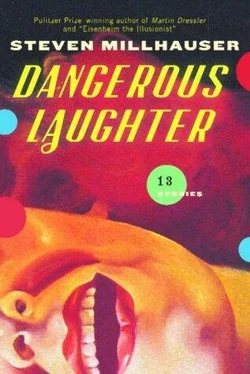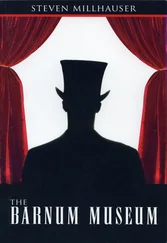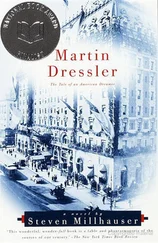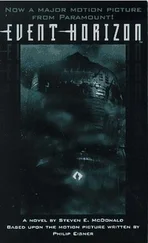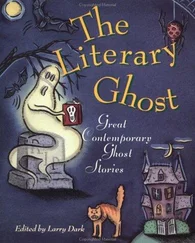As the fashion for more and more fabric spread from the pages of popular magazines, where the new models posed with turned-aside faces and downcast eyes, to the middle-class housewife and her daughters, a group of emerging designers on both coasts began to attract attention. They were young, imperious, and contemptuous of the recent past. Among the creators the most daring and secretive was one who signed his clothes with a small gold H in a blood-red circle. He refused to be photographed; in a spirit of irony or bravado, he called himself Hyperion.
At this time the long style still clung to the shape of the female body. It was Hyperion who took the decisive leap away from the body toward regions of high invention. In a celebrated autumn catwalk show, he shocked viewers by bringing back a version of the Victorian crinoline, with its hoops of flexible steel, and raising it to the level of the shoulders. Now a woman could walk hidden in a hemispheric ripple of wire-supported silk or velvet that fell from her shoulders to the floor. Although the hemi-dress was ridiculed by a number of fashion commentators for its awkwardness, its ugliness, its retro-kitsch jokiness, its air of mockery, others saw in it an expression of liberation from the tyranny of the body. Before the show, the history of women’s fashion was a record of shifts of attention from one part of the body to another. With a single design, Hyperion had freed fashion from its long dependence on the female shape.
A brief and unsatisfactory geometric period — the pyramid dress, the octagon dress — was followed by the creation of the free style, which rejected symmetry altogether. Now women adorned themselves in free-floating designs that seemed intent on allowing fabric to explore its inner nature, to fulfill secret necessities. There were dresses with troubling structures that burst from the shoulders and waist and swooped up in arabesques of velvet and satin; aggressively long dresses with silk-lined trains that, raised and fastened about the neck, formed a kind of shimmering and ecstatic plumage; horizontal dresses; dresses like delirium dreams, dresses like feverish blossoms blazing in the heart of impenetrable jungles; dresses composed of synthetic fabrics specially developed to assume the appearance of thunderclouds, of swirling snow, of tongues of fire. It was as if dresses had become stricken with boredom, with impossible desires. Whereas fashion extravagances of the past — the Elizabethan farthingale, the horsehair bustle of the 1870s — had always emphasized and exaggerated some part of the female anatomy, the new shapes ignored the body entirely, while at the same time they seemed to express inner moods, forgotten dreams, buried realms of feeling. Teenage girls in particular embraced the Hyperion free style, with its double pleasure of secrecy and exposure — for they could plunge down, far down, into layers of costume that sheltered them from sight, while rivers of twisting cloth allowed them to bring forth forbidden longings.
Meanwhile the female face, which had hovered somewhat uncertainly above the early Hyperion dresses, began to be absorbed by the new designs. A petal collar, composed of lanceolate shafts of cloth, rose to the hairline; colorful wraps known as neckbands reached above the chin; elaborate head coverings swept down to the bodice. Even more remarkable was the development on the surface of dresses: new shapes sprang from folds of cloth, secondary growths that seemed to lead separate lives, like gargoyles sprouting in the corners of cathedrals.
Although the Hyperion free style was above all notable for its refusal to reveal the female body, commentators were quick to point out that the fashion for concealment was not without an erotics of its own. The direct and simple provocations of the old style — a bare stomach, a nipple pressing through a tight sweater — were replaced by indirection, disguise, and a vague suggestiveness. In the new style, the imagination was said to be stimulated to an unusual degree: beneath those lavish swirls of fabric, playful and at times forbidding, lay a hidden body, inviting discovery. One fashion writer compared the free-style dress to the series of obstacles facing a medieval knight adventuring through a dark forest toward his mistress held captive in the tower of a distant castle guarded by an ogre. That sense of difficulty, of seductive impediment, was increased by elaborations of lingerie permitted by the new volume — beneath the vast skirts bloomed a garden of lace-trimmed petticoats in raspberry chiffon and black organdy, crimson silk half-slips with side slits, stretch-satin and dotted-mesh chemises with ruffle trim. Teenage girls, who a year earlier had reveled in their thongs and V-strings, led the way in adopting an excess of underclothes, holding contests in high school bathrooms to see who was wearing the greatest number of layers, in vivid and hidden colors: sunburst yellow, vermilion, ice blue. But quite apart from this development, which drew attention to new depths of concealment and thus to the veiled body itself, several commentators pointed out that it was not strictly accurate to speak of the complete covering of the female form. Beyond the neckbands and high collars, parts of the face continued to be visible, thereby reminding the observer of unseen portions of the body, which were helplessly summoned to the imagination. In addition, women concealed in Hyperion free-style dresses moved from place to place, so that the creations shook and swayed; now and then, a hidden arm or leg might press visibly against a portion of fabric. Stimulated by the unseen, lashed by the unknown, sexual fantasies became at once more violent and more devious. The new clothing was essentially paradoxical. Women, it was argued, were never more naked than when concealed from view.
Indeed one feature of the new style was its appeal to women who longed to inspire fiery passions but who judged their visible bodies to be inadequate or repellent. Beneath the Hyperion dress a woman could rest secure in the knowledge that her body, safely shut away, could become whatever she wished it to be, down there in the dark below distractions of fabric that seemed to tremble on the edge of dream.
Fashion is an expression of boredom, of restlessness. The successful designer understands the ferocity of that boredom and provides it with new places in which to calm its rage for a while. Even as Hyperion free-style dresses were displayed in photo spreads in international magazines and promoted in vigorous poster campaigns, the designer was preparing his next step. In his eagerly awaited spring/summer collection, he proclaimed the final liberation of costume from the female body. The new dress completed the urge to concealment by developing the bodice upward into a complete covering for the face and head. Now the Hyperion dress entirely enclosed the wearer, who was provided with artful spaces for the mouth, nostrils, and eyes. The new top quickly developed a life of its own. It seemed determined to deny the existence of the head, to use the area between collarbone and scalp as a transitional element, by expanding the idea of a dress upward to include the space above the height of the wearer. Meanwhile the openings for eyes and nostrils, which had drawn attention to the concealed face and threatened to turn the dress into a species of mask, were replaced by an opaque fabric that permitted one-way vision. Women, who had gradually been disappearing into the hidden spaces of the new style, had at last become invisible.
Commentators welcomed the enclosure dress but were divided over its merits. Some argued that it represented the ultimate defense of the female body against visual invasion, while others saw in it the final liberation of costume from its demeaning dependence on the body. One fashion writer praised what she called the vanished woman and compared the enclosure dress to the development of the boudoir, or private sitting room, in the eighteenth-century house — a secret domain in which a woman could be herself, safe from male control. A rival journalist, ignoring women and their desires, spoke only of the new aesthetic of costume, which at last was free to develop in the manner of landscape painting after it had become bold enough to exile the human figure.
Читать дальше
